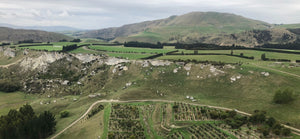Growing Truffles
Large areas with suitable soil and climatic conditions are present in New Zealand but this does not mean automatic success in growing truffles. A number of key conditions must be satisfied and considered in order to successfully grow truffles in a plantation setting. These differ depending upon the variety of truffle used and the host tree (unless specified, the information supplied is referred to growing Tuber melanosporum).
Some of the growing conditions needed
A suitable pH (in excess of about 7.6), either from naturally occurring limestone soils or by artificially applying limestone to other soil types; A very friable, well aerated soilSufficient moisture at key times throughout drier months; An absence of competing fungi; Warm summer temperatures (days in excess of 30 degrees Celsius); A frost period in winter (which triggers fruiting); A relatively dry climate; Consider a gentle contour for ease of management
Tree planting suggestions
Plant in spring or autumn after/before the worst of the frosts into weed free and well cultivated soil; If spraying use a non-residual herbicide like ‘Buster’ but don’t use ‘Glyphosate’ as it is detrimental to soil fungi to prepare soil for planting; Plant spacing varies depending on site, tree and truffle type; DO NOT over fertilise the soil at planting as you risk killing off the truffle fungi. Avoid salt based fertilisers such as DAP, Nitrophoska etc. Blood and bone would be a good choice; Disturb the roots as little as possible; Ensure that the potting mix is well covered with soil; Water in well
Put a 60 x 15cm tall KBC shelter with stake on each tree. This will help to protect against frost, pests, wind and sprays; Put a 20 – 40cm diameter mulch mat around each tree if you wish

Site Management
In the truffiere the aim is to grow dense, active root systems, because that is where the fungus lives. The more new roots growing the more chance of truffle. Once the trees are growing, the annual husbandry involves:
Maintenance of suitable pH levels (by way of liming in the case of non-limestone soils); Maintenance of key trace element levels (Iron, Magnesium, Boron in particular); Maintenance of healthy tree growth (soil testing and fertilising, leaf analysis and foliar nutrient spraying); Pruning excessive tree growth, keeping the tree forever a “teenager”, preventing any shading in the truffle growing area (to allow high soil temperatures to form); Controlling excessive weed/grass growth at the base of the host trees until such point as the brule take over (a brule is the naturally occurring “burnt patch” whereby the fungus suppresses competitive plant growth – in a similar manner to a mushroom ring). A brule usually begins to develop after three to four years; Controlling pests which include rats and mice, hares and rabbits, digging and defecating dogs, and slugs; Aerating if necessary, by cultivation, the soil around the tree at the start of the truffle growing season (spring); When necessary maintaining required soil moisture levels by sprinkler irrigation (over the truffle growing period of December through to February); Minimising trampling/machinery effects of any kind to the soil over the later summer and harvesting period (January through August); Through the harvest period (June to late August in Canterbury) regularly (at least once per week) searching with a trained dog for ripe truffles
Harvesting your truffles
Truffles are harvested using specially trained dogs. Female pigs were historically used to indicate where individual truffles were by smelling them out, but today dogs are more commonly used as they are easier to control. Handlers carefully dig out the truffle, which can be as much as 30cm below the surface.
It takes a lot more time and patience than first thought to harvest the truffle and it is something often overlooked when people start setting up their own truffle site. As more growers are starting to produce truffles in New Zealand, truffle dog handling services have started to become available whilst others are happy to train their own dog. What ever you choose to do, it is something that needs to be considered early on as it can often mean the success (or failure) in the truffle growing process – without the dog the truffle is near impossible to find!
A word of caution
This is a guideline only and does not guarantee success, however these husbandries are in use at a producing truffiere near Waipara, North Canterbury, that is owned by Kings Truffles. This truffiere has over 1000 trees aged between 10 – 20 years and it regularly produced truffles for a number of years, commencing about 8 years after first planting. However, it was non-producing and run down when it was taken over by Kings Truffles in 2008. Following the implementation of a new husbandry regime, it has increased production of truffles each year since 2009.
Kings Truffles also has another 4000 young trees following the above guidelines.
